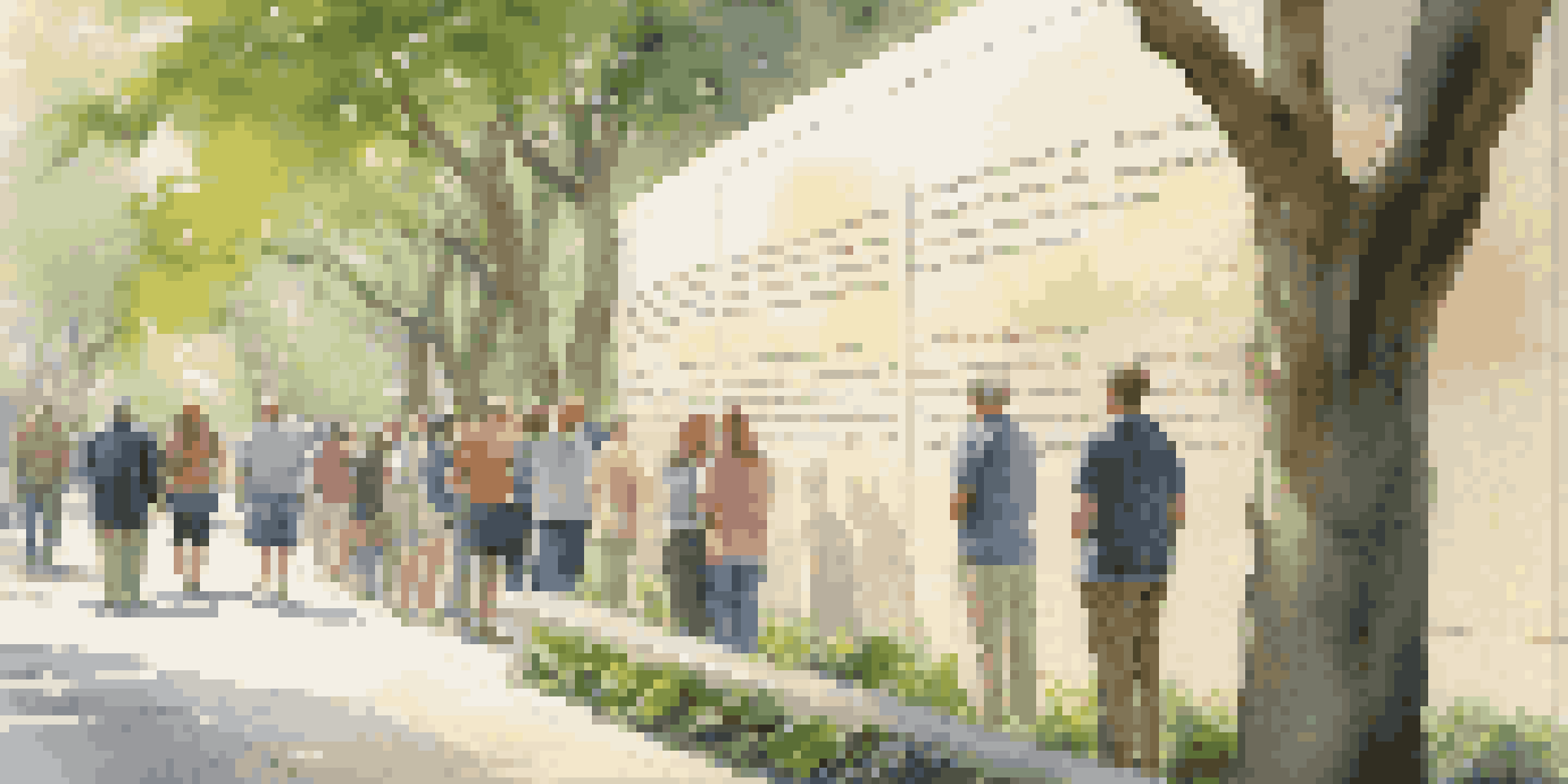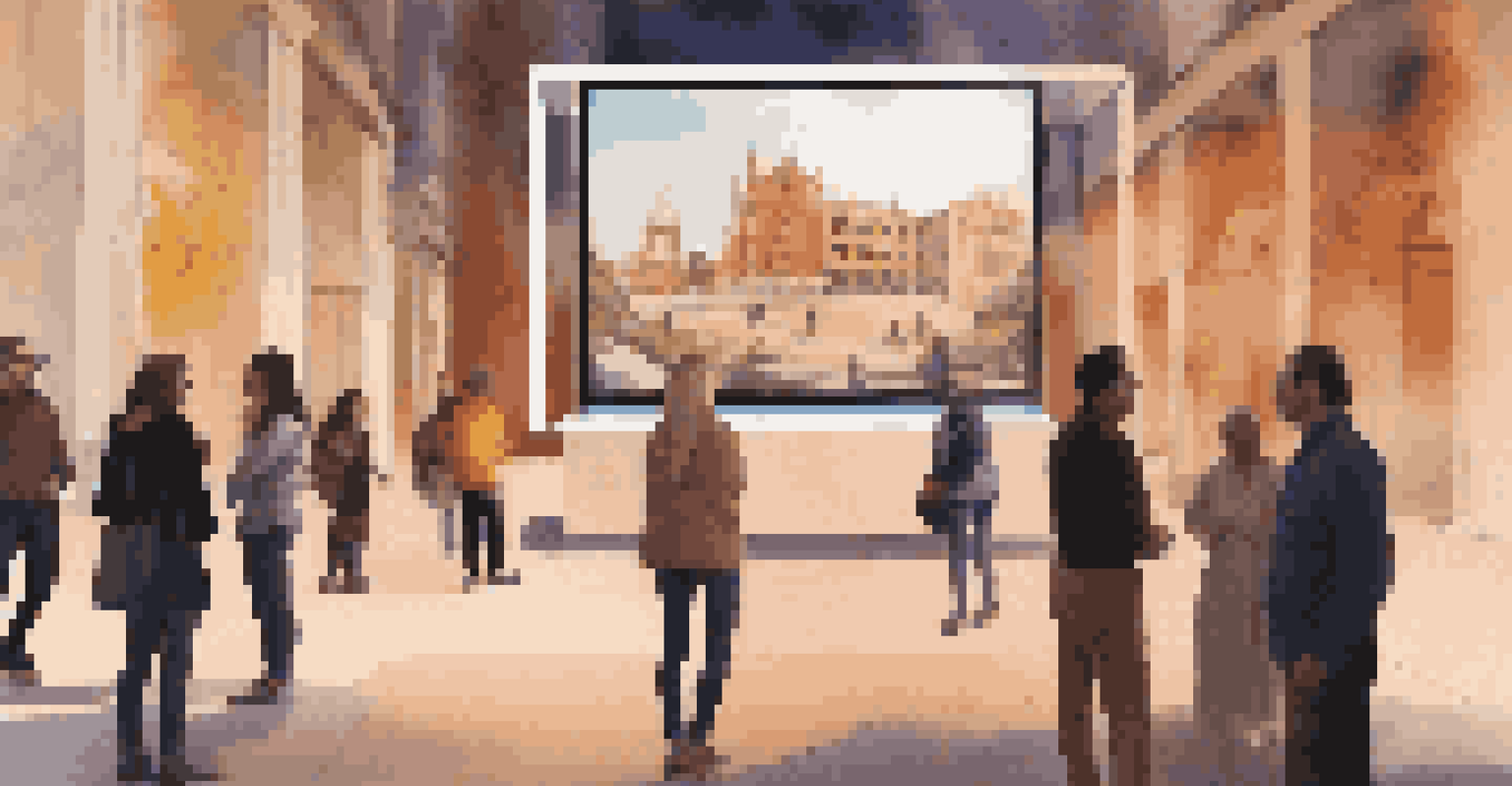Art and Memory: The Influence of Public Commemoration

The Role of Art in Remembering Events
Art plays a crucial role in how we remember significant events. From murals to sculptures, public art serves as a visual reminder of moments that have shaped our history. These artistic expressions not only commemorate but also foster a sense of community and identity.
Art is not what you see, but what you make others see.
For instance, consider the Vietnam Veterans Memorial in Washington, D.C. Its reflective surface invites visitors to connect with the past, honoring those who served while encouraging personal reflection. This interaction with art helps individuals process collective grief and memory.
Through art, memories are preserved in a way that words alone often cannot achieve. The emotional resonance of a piece can evoke memories and feelings, creating a shared experience that binds people together across generations.
Public Commemoration and Community Identity
Public commemoration through art can significantly influence community identity. These artistic monuments serve as focal points for community pride and remembrance, reinforcing shared values and experiences. They remind us of our collective past and inform our present identity.

Take, for example, the countless statues and memorials dedicated to local heroes. These pieces not only celebrate individual achievements but also symbolize the values that communities hold dear, fostering a sense of belonging among residents.
Art Preserves Collective Memory
Art serves as a powerful means of preserving and sharing memories, allowing communities to connect with their past.
As communities evolve, so too can the narratives represented in public art. New memorials can address previously overlooked histories, allowing for a broader, more inclusive understanding of community identity.
Art as a Tool for Social Change
Art has long been a powerful tool for social change, and public commemoration is no exception. By highlighting specific events or figures, artists can provoke thought and discussion, pushing communities to confront uncomfortable truths. This engagement can lead to meaningful dialogue and, ultimately, change.
The purpose of art is not a rarified, intellectual distillate; it is life, intensified, on the edge of the precipice.
Consider the powerful murals that emerged during the civil rights movement. These artworks not only documented the struggle for equality but also inspired action and solidarity among supporters. They continue to resonate today, reminding us of the ongoing fight for justice.
Through public art, communities have the opportunity to voice their values and aspirations, challenging the status quo. This dynamic interaction between art and activism showcases the potential for art to effect real change.
The Emotional Connection of Commemorative Art
Commemorative art often evokes deep emotional responses, creating a lasting connection between the viewer and the subject. This emotional engagement is crucial in how we remember and honor those we've lost or the events we've experienced. Art can encapsulate the essence of a moment, allowing us to revisit our emotions time and again.
For example, the poignant imagery of 9/11 memorials serves not just as a reminder of loss but as a way to honor resilience and hope. The act of visiting these sites becomes a shared emotional experience, connecting people through their collective grief.
Public Art Shapes Community Identity
Memorials and monuments play a significant role in fostering a sense of belonging and pride within communities.
This emotional resonance is what makes public art so powerful; it transforms memory from a passive act into an active engagement with our history and emotions.
Challenges in Public Commemoration
Despite the positive aspects of public commemoration, there are challenges that can arise. Disputes over which events or figures are worthy of memorialization can lead to conflicts within communities. This highlights the subjective nature of memory and how it can vary across different cultural perspectives.
A notable example is the debate surrounding Confederate monuments in the United States. These monuments have become focal points for discussions about race, history, and identity, prompting communities to reassess who and what they choose to commemorate.
Navigating these challenges requires sensitivity and open dialogue, as communities strive to find common ground in their shared histories while respecting diverse viewpoints.
Future Directions in Commemorative Art
As society evolves, so too does the landscape of commemorative art. The future of public commemoration could involve more interactive and multimedia installations, engaging audiences in new and innovative ways. Technology can enhance these experiences, allowing for deeper connections with the subject matter.
For instance, augmented reality could bring historical events to life, allowing viewers to interact with the past in a more immersive fashion. This could redefine how we understand and appreciate the narratives behind commemorative art.
Art Drives Social Change
Through public art, communities can address social issues and inspire dialogue, highlighting the potential for art to effect change.
Ultimately, the future of public commemoration will likely reflect the changing values and priorities of society, ensuring that art remains a vital part of how we remember and learn from our history.
Art and Memory: A Continuous Dialogue
The relationship between art and memory is an ongoing dialogue that shapes our understanding of the past. Public commemoration allows us to engage with history in a tangible way, fostering connections between individuals and communities. This dialogue is essential for keeping memories alive and relevant.
By reflecting on the art that commemorates our shared experiences, we can better appreciate the diverse narratives that exist within our communities. Each piece of art carries with it a story, waiting to be explored and understood.

As we move forward, it's important to continue nurturing this dialogue, ensuring that art remains a powerful medium for remembrance and connection.